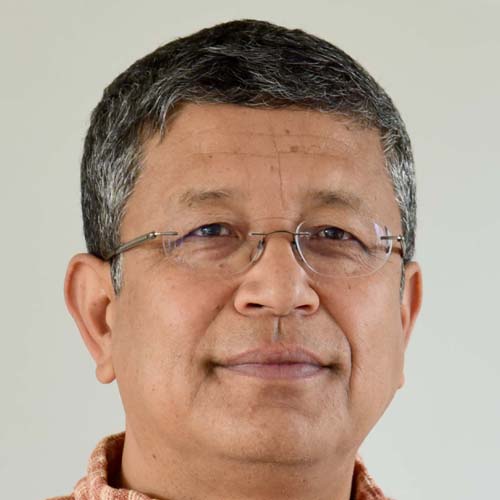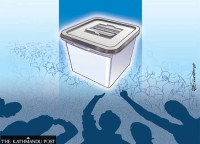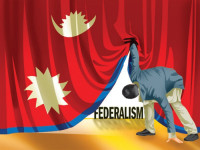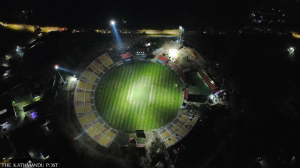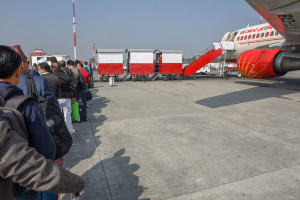Columns
Completely lost in translation
It would be too much to expect perfect translations when authorities get even the most basic terms wrong.
Deepak Thapa
At an academic meet on human mobility several years ago, a French scholar was beginning to look visibly uncomfortable before she ventured to ask why some participants were bandying about the term ‘alien’ when referring to a certain category of people in the United States. She was probably protesting that people be spared that descriptor because it conjured up images of ‘alien-looking’ creatures made famous by sci-fi movies, and, for those of a certain generation, comic books as well. It was only after she was informed that that was how the US government referred to everyone not an American citizen did she appear somewhat mollified.
‘Alien’ certainly does refer to both extra-terrestrials and non-citizens, but given how popular culture has appropriated it for the former, the source of the scholar’s unease was quite justified. And neither would she be the first so disconcerted when dealing with American officialdom. Many would have felt equally disturbed when asked to state their ‘race’ while filling out all manner of forms in the US. When first confronted with it, I struggled to mark ‘Asian’ since I could visualise East Asians, West Asians, South Asians and everyone in between and wondered how helpful the category ‘Asian’ could be for any useful purpose. Things have evolved since and now besides, white, black, etc, the US census has also begun listing six major Asian groups—Chinese, Vietnamese, Filipino, Korean, Asian Indian and Japanese—while also allowing the possibility of being ‘Other Asian’, which helpfully lists, Pakistani, Cambodian and Hmong as examples (although Nepalis are yet to make the grade).
The whole point, it seems, was to find out people’s nation of origin, and ‘race’ itself had nothing to do with it. Which is just as well since the use of ‘race’ to classify different groups of people has long been decried in academia. Consider the 1998 statement from the American Anthropological Association (AAA). ‘Historical research has shown that the idea of “race” has always carried more meanings than mere physical differences; indeed, physical variations in the human species have no meaning except the social ones that humans put on them,’ argued the AAA. ‘The “racial” worldview was invented to assign some groups to perpetual low status, while others were permitted access to privilege, power, and wealth.’
It seems that the US Census Bureau never got the AAA memo. Neither, it turns out, did our own officials, since government documents in the English translation are replete with references to ‘race’ when it is clear that the term is meant to denote something else. Take, for instance, the National Penal (Code) Act, 2017, in its English translation by the Ministry of Law, Justice and Parliamentary Affairs. All the references to jat and jati in the original Nepali (and they are always twinned) have been translated, respectively, as ‘caste’ and ‘race’. We know very well who ‘caste’ refers to, but as for who constitutes racial groups is unknown. Unless, of course, the intent was to call all those who do not belong to any of the caste groups as being part of some kind of low-status race.
At the same time, though, the Nepal Law Commission’s English translation of the Constitution of Nepal, 2015, has used ‘tribe’ for ‘jati’. Thus, according to our government, ‘race’ and ‘tribe’ are one and the same. I think the mix-up comes from the official translators relying only on English-Nepali and/or Nepali-English dictionaries, where ‘jati’ can certainly be found to be defined as both ‘race’ and ‘tribe’ and vice versa. The translators appear quite oblivious of the larger socio-political context in which meanings have been ascribed to these terms and how new formulations have evolved over time.
It was nearly three decades ago that the late Harka Gurung had authoritatively laid out the distinction between ‘jat’ and ‘jati’. ‘The terms jat and jati have a common etymology in the sense of species,’ he wrote. ‘However, native usage makes a subtle distinction of the former as “caste” and the latter as “ethnic” group. This conforms to the linguistic connection of jati being subsidiary to jat and reflects well the reality of jat dominance in Hindu Nepal...Jat (caste) groups are vertically stratified according to ritual status while Jati (ethnic) groups are differentiated by culture and space.’
Tribes to ethnics
There are indeed people who are fixated on the idea of ‘race’ and believe Nepal is home to Mongols and Aryans (and some Dravidians), i.e., people who continue to carry the same blood as their (oftentimes-presumed) ancestors millennia ago. But these folks are mainly on the fringes. What is widely accepted, though, is the idea of ‘jat’ and ‘jati’ in Nepal, as pointed out by Gurung above, and for many years, the accepted translation of ‘jati’ was ‘tribe’. The well-known study of Limbus by anthropologist Lionel Caplan from the 1960s was actually subtitled, ‘A Study of Hindu-Tribal Relations’, with Bahuns called Hindus and Limbus, tribals.
I could find the first mention of ‘jati’ back in the abortive 1948 constitution of the late Rana period, when it referred in one place to bills related to changes in the religious practices of any ‘jati’ or institution. It is unclear what it meant by ‘jati’ (although the translation by the renowned ConstitutionNet seems to be way off in referring to it as ‘class’). The Interim Constitution of 1951 has four references to ‘jati’ (which ConstitutionNet has translated as ‘race’). Thereafter, all the constitutions make liberal use of ‘jati’ (along with ‘jat’) and translated most often as ‘tribe’.
Over time, of course, the term ‘tribe’ has fallen into disuse. Another anthropologist, Gerard Toffin, notes: ‘Contrary to India, where it has a legal status (for example, Scheduled Tribe), the word tribe is not used in Nepal. For most Nepalese, “tribe” has a derogatory meaning. Even anthropologists working in this country prefer the expression “ethnic group”.’
That it continues to feature in government documents is no surprise though. It would be too much to expect perfect translations when they get even the most basic terms wrong. Thus, we can still see the embossed number plates on motor vehicles sporting ‘State 3’ when it should have been ‘Province 3’. Our Constitution recognises ‘pradesh’ (province) and not ‘rajya’ (state). That should have been clear to the government translators given our close proximity to India, which is divided into many ‘rajya’, and hence has an upper house of parliament called the Rajya Sabha, the Council of States. Or, they could have even considered what the United States of America is called in Nepali—Samyukta Rajya America. Yet, the Ministry of Law, Justice and Parliamentary Affairs continues to refer to our pradesh as ‘state’ in its own translation of the constitution.
None of this should matter since the Nepali original is meant to prevail in case of any confusion. But as there are many who rely only on the English versions, these unfortunates will be forced to reckon with the idea of Nepal being full of races and tribes—and many more incongruencies in the very official translations of official documents.




 19.12°C Kathmandu
19.12°C Kathmandu